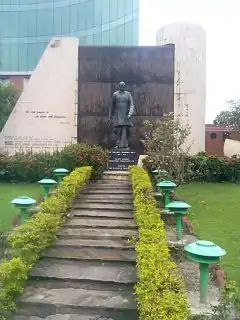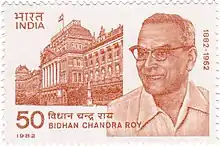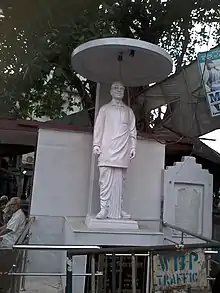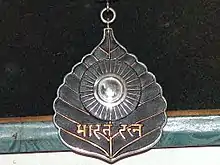Bidhan Chandra Roy
Bidhan Chandra Roy MD, DSc, MRCP, FRCS (1 July 1882 – 1 July 1962) was an eminent Indian physician, educationist, philanthropist, freedom fighter and politician who served as the Chief Minister of West Bengal from 1948 until his death in 1962. Bidhan Roy is often considered the Maker of Modern West Bengal[1] due to his key role in the founding of several institutions and five eminent cities, Durgapur, Kalyani, Bidhannagar, Ashokenagar and Habra. He is one of the few people in history to have obtained F.R.C.S. and M.R.C.P. degrees simultaneously. In India, the National Doctors' Day is celebrated in his memory every year on 1 July. He was awarded Bharat Ratna on 4 February 1961, India's highest civilian honour.[2]
Bidhan Chandra Roy | |
|---|---|
.jpg.webp) Roy in 1943 | |
| 2nd Chief Minister of West Bengal | |
| In office 23 January 1948 – 1 July 1962 | |
| Governor | C. Rajagopalachari Kailash Nath Katju Harendra Coomar Mookerjee Phani Bhusan Chakravartti Padmaja Naidu |
| Preceded by | Prafulla Chandra Ghosh |
| Succeeded by | Prafulla Chandra Sen |
| Member of West Bengal Legislative Assembly | |
| In office 1952–1962 | |
| Preceded by | Constituency established |
| Succeeded by | Bijoy Singh Nahar |
| Constituency | Bowbazar |
| In office 1962–1962 | |
| Preceded by | Bijoy Singh Nahar |
| Succeeded by | Siddhartha Shankar Ray |
| Constituency | Chowranghee |
| 6th Mayor of Kolkata | |
| In office 5 April 1931 – 9 April 1933 | |
| Preceded by | Subhas Chandra Bose |
| Succeeded by | Santosh Kumar Basu |
| Personal details | |
| Born | 1 July 1882 Bankipore, Patna Bengal Presidency, British India |
| Died | 1 July 1962 (aged 80) Kolkata, West Bengal, India |
| Political party | Indian National Congress |
| Parents | Aghore Kamini Devi Prakash Chandra Roy |
| Residence | Kolkata, West Bengal, India |
| Alma mater | Presidency College (IA) Patna University (BA) Calcutta Medical College (MBBS, MD) Royal College of Physicians (MRCP) Royal College of Surgeons (FRCS) |
| Profession | |
| Awards | Bharat Ratna (1961) |
Family history
Bidhan Chandra Roy's grandfather Prankali Roy was an employee of Baharampur collectorate in Murshidabad district, West Bengal. Thus his father Prakash Chandra Roy was born in the year of 1847 at Baharampur, Murshidabad district in present-day West Bengal, India. Bidhan Chandra Roy's mother Aghorkamimi Devi was the daughter of a Zamindar of Baharampur named Bipin Chandra Bosu.[3]
Early life and education
Bidhan Chandra Roy was born to a Bengali baidya family on 1 July 1882 at Bankipore, Patna, Bihar, where his father, Prakash Chandra Roy, was working as an excise inspector. His mother, Aghore Kamini Devi, was a pious lady and a devoted social worker.[4] Bidhan was the youngest of five siblings – he had 2 sisters, Susharbashini and Sarojini, and 2 brothers, Subodh and Sadhan. Bidhan's parents were ardent Brahmo Samajists, led an austere and disciplined life, and devoted their time and money to the service of everyone in need, irrespective of caste or creed.[5]
Prakash Chandra was a descendant of the family of the rebel Hindu king of Jessore, Maharaja Pradapaditya, but did not inherit much wealth from his ancestors. He earned only a moderate salary for most part of Bidhan's childhood, yet he and Aghore Kamini supported the education and upbringing of not just their own children but also a number of other poor children, mostly orphans. The spirit of 'give and take' was inculcated in Bidhan and his siblings from their tender years. They were taught and even encouraged to give away what was precious to them, freely and willingly.[3]
Bidhan completed his matriculation from Patna Collegiate School in 1897, obtained his I.A. degree from Presidency College, Calcutta and B.A. from Patna College with Honors in Mathematics. After completing his graduation in mathematics, he applied for admission to the IIEST formerly BESU and the Calcutta Medical College. His application was accepted by both institutions and he opted to pursue medical studies. Bidhan left Patna in June 1901 to join the Calcutta Medical College. While at medical school, Bidhan came upon an inscription which read, "Whatever thy hands findeth to do, do it with thy might."[6] These words became a lifelong source of inspiration for him.
The partition of Bengal was announced while Bidhan was in college. Opposition to the partition was being organised by nationalist leaders like Lala Lajpat Rai, Tilak and Bipin Chandra Pal. Bidhan resisted the immense pull of the movement. He controlled his emotions and concentrated on his studies, realising that he could serve his nation better by qualifying in his profession first.[7]
Intending to enroll himself at St Bartholomew's Hospital to pursue postgraduate study in medicine, Bidhan set sail to England in February 1909 with only ₹ 1200. However, the Dean of St. Bartholomew's Hospital was reluctant to accept an Asian student and rejected Bidhan's application.[8] Dr. Roy did not lose heart but kept submitting his application again and again till the Dean, after 30 admission requests, admitted Bidhan to the college.[9] Bidhan completed his postgraduation in just two years and three months, and in May 1911 accomplished the rare feat of becoming a member of the Royal College of Physicians and a fellow of the Royal College of Surgeons simultaneously. He returned home from England in 1911.
Career



Immediately after graduation, Roy joined the Provincial Health Service. He exhibited immense dedication and hard work, and would even serve as a nurse when necessary. In his free time he practised privately, charging a nominal fee.
Following his return from England after post-graduation, he taught at the Calcutta Medical College, and later at the Campbell Medical School and the Carmichael Medical College.[7]
Dr. Roy believed that swaraj (the call to action for India's freedom) would remain a dream unless the people were healthy and strong in mind and body. He made contributions to the organisation of medical education. He played an important role in the establishment of the Jadavpur T.B. Hospital, Chittaranjan Seva Sadan, Kamala Nehru Memorial Hospital, Victoria Institution (college), and Chittaranjan Cancer Hospital. The Chittaranjan Seva Sadan for women and children was opened in 1926. Women were unwilling to come to the hospital initially, but thanks to Dr. Roy and his team's hard work, the Seva Sadan was embraced by women of all classes and communities. He opened a center for training women in nursing and social work.
In 1942, Rangoon fell to Japanese bombing and caused an exodus from Calcutta fearing a Japanese invasion. Dr. Roy was serving as the Vice-Chancellor of the University of Calcutta. He acquired air-raid shelters for schools and college students to have their classes in, and provided relief for students, teachers and employees alike. In recognition for his efforts, the Doctorate of Science was conferred upon him in 1944.
Dr. Roy believed that the youth of India would determine the future of the nation. He felt that the youth must not take part in strikes and fasts but should study and commit themselves to social work. While delivering the Convocation Address at the University of Lucknow on 15 December 1956, Dr. Roy said:[10][11]
My young friends, you are soldiers in the battle of freedom-freedom from want, fear, ignorance, frustration and helplessness. By a dint of hard work for the country, rendered in a spirit of selfless service, may you march ahead with hope and courage...
Dr. Roy was both Gandhiji's friend and doctor. When Gandhiji was undertaking a fast in Parnakutivin, Poona in 1933, Dr. Roy attended to him.[12] Gandhiji refused to take medicine on the grounds that it was not made in India. Gandhiji asked Dr. Roy, "Why should I take your treatment? Do you treat four hundred million of my countrymen free?" Dr. Roy replied, "No Gandhiji, I could not treat all patients free. But I came... not to treat Mohandas Karamchand Gandhi, but to treat "him" who to me represents the four hundred million people of my country." Gandhiji relented and took the medicine.
Dr. Roy entered politics in 1925. He ran for elections from the Barrackpore Constituency as an independent candidate for the Bengal Legislative Council and defeated the "Grand Old Man of Bengal," Surendranath Banerjee. Even though an independent, he voted with the Swaraj Party (the Parliamentary wing of the Congress in the 1920s). As early as 1925, Dr. Roy tabled a resolution recommending a study of the causes of pollution in Hoogly and suggested measures to prevent pollution in the future.
Dr. Roy was elected to the All India Congress Committee in 1928. He kept himself away from rivalry and conflicts and made a deep impression on the leaders. Dr. Roy efficiently conducted the Civil Disobedience in Bengal in 1929 and prompted Pandit Motilal Nehru to nominate him Member of the Working Committee (CWC) in 1930. The CWC was declared an unlawful assembly and Dr. Roy along with other members of the committee were arrested on 26 August 1930 and detained at Alipore Central Jail.
During the Dandi March in 1931, many members of the Calcutta Corporation were imprisoned. Congress requested Dr. Roy to remain out of prison and discharge the duties of the Corporation. He served as the Alderman of the Corporation from 1930–31 and as the Mayor of Calcutta from 1931 to 1933. Under him, the Corporation made leaps in the expansion of free education, free medical aid, better roads, improved lighting, and water supply. He was responsible for setting up a framework for dispensing grant-in-aid to hospitals and charitable dispensaries.
Post independence
The Congress Party proposed Dr. Roy's name for Chief Minister of Bengal. Dr. Roy wanted to devote himself to his profession. On Gandhiji's advice, however, Dr. Roy accepted the position and took office on 23 January 1948. Bengal at the time had been torn by communal violence, shortage of food, unemployment and a large flow of refugees in the wake of the creation of East Pakistan. Dr. Roy brought unity and discipline among the party ranks. He then systematically and calmly began to work on the immense task in front of him. Within three years law and order was returned to Bengal without compromising the dignity and status of his administration. He told the people:[10]
We have the ability and if, with faith in our future, we exert ourselves with determination, nothing, I am sure, no obstacles, however formidable or insurmountable they may appear at present, can stop our progress... (if we) all work unitedly, keeping our vision clear and with a firm grasp of our problems.
The nation honoured Dr. Roy with the Bharat Ratna on 4 February 1961. On 1 July 1962, his 80th birthday, after treating his morning patients and discharging affairs of the State, he took a copy of the "Brahmo Geet" and sang a piece from it. 11 hours later Dr. Roy died at midday past three. He had gifted his house for running a nursing home named after his mother, Aghorkamini Devi. He had also constituted a trust for his properties at Patna to carry out social service, with eminent nationalist Ganga Sharan Singh (Sinha) being its first trustee.[13]
The B.C. Roy National Award was instituted in 1962[14] in Dr. Roy's memory and has been awarded annually since 1976. The award recognizes excellent contributions in the areas of medicine, politics, science, philosophy, literature and arts. The Dr. B.C. Roy Memorial Library and Reading Room for Children in the Children's Book Trust, New Delhi, was opened in 1967. Today, his private papers are part of the Archives at the Nehru Memorial Museum & Library, at Teen Murti House, Delhi.[15][16]
References
- Kalra, R. N. (3 July 2011). "A doctor par excellence". The Hindu. ISSN 0971-751X. Retrieved 27 August 2018.
- Dr Bidhan Chandra Roy: Vision for young India – The 15 'Gods' India draws inspiration from Archived 26 November 2009 at the Wayback Machine. News.in.msn.com (20 November 2009). Retrieved on 9 October 2013.
- Nandalal Bhattacharya (2004). Karmajogi Bidhanchandra (Life of Bidhan Chandra Roy) (in Bengali). Grantha-tirtha. p. 15 & 16.
- "Biography of Bharat Ratna "Dr. Bidhan Chandra Roy" complete biography for Class 10, Class 12 and Graduation and other classes". eVirtualGuru. 1 February 2018. Retrieved 1 September 2018.
- Thomas, K.P. (1955). Dr. B. C. Roy (PDF). Calcutta: Atulya Ghosh, West Bengal Pradesh Congress Committee. Archived from the original (PDF) on 2 September 2018. Retrieved 1 September 2018.
- "Remembering Dr Bidhan Chandra Roy: Facts about the doctor who dedicated his life to the profession of medicine". India Today. 1 July 2017.
- "Bidhan Chandra Roy Biography – Bidhan Chandra Roy Childhood, Life, Profile, Timeline". www.iloveindia.com. Retrieved 25 August 2018.
- "Dr Bidhan Chandra Roy -Biography and Life History | Great Rulers". greatrulers.com. Archived from the original on 28 August 2018. Retrieved 27 August 2018.
- "When India's 'National Doctor' Was Denied Service By an American Restaurant". The Wire. Retrieved 28 August 2018.
- "Bengal's physician chief minister – The Statesman". The Statesman. 30 June 2016. Retrieved 26 August 2018.
- "New Incubators for Tomorrowís Leaders. Convocation Address by Prof. Samir K. Brahmachari, Director General, CSIR at Kalyani University" (PDF). CSIR Newsletter. 60: 258. November 2010.
- "Chronology 1933". gandhiserve.org. Archived from the original on 26 August 2018. Retrieved 26 August 2018.
- Choudhary, Valmiki (1984). Dr. Rajendra Prasad, Correspondence and Select Documents: 1934–1937. Allied Publishers. p. 133. ISBN 978-81-7023-002-1.
- "Dr. B.C. Roy Award | MCI India". www.mciindia.org. Retrieved 28 August 2018.
- NMML. "Archives". www.nehrumemorial.nic.in. Retrieved 26 August 2018.
- "India's Iconic Doctor: Dr. Bidhan Chandra Roy| DailyRounds". www.dailyrounds.org. Archived from the original on 26 August 2018. Retrieved 26 August 2018.
| Wikimedia Commons has media related to Bidhan Chandra Roy. |
| Wikiquote has quotations related to: Bidhan Chandra Roy |
| Political offices | ||
|---|---|---|
| Preceded by Prafulla Chandra Ghosh |
Chief Minister of West Bengal 1948–1962 |
Succeeded by President's Rule |
